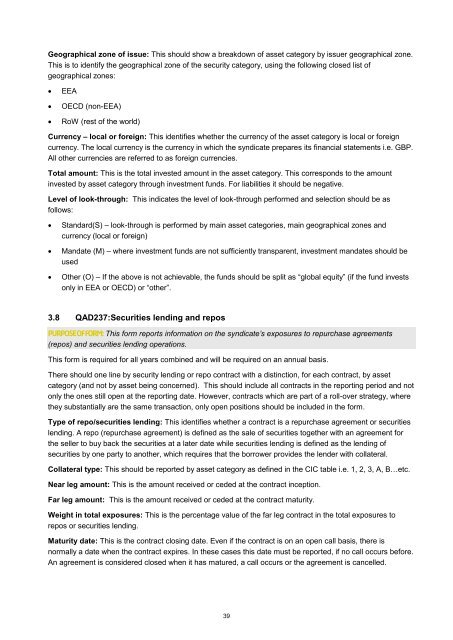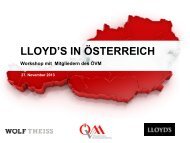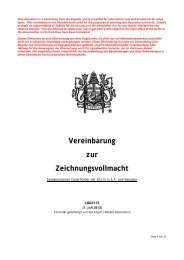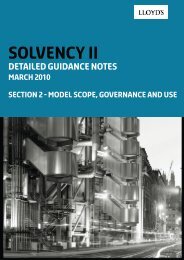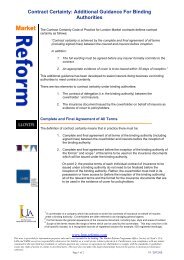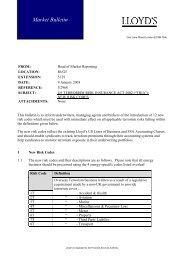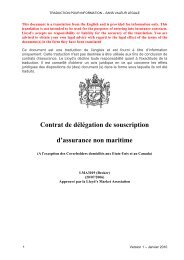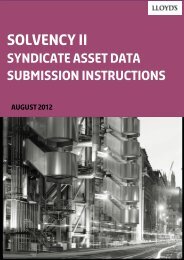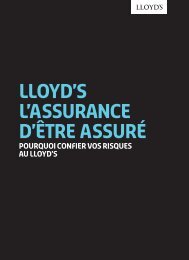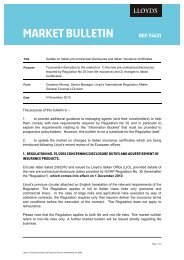You also want an ePaper? Increase the reach of your titles
YUMPU automatically turns print PDFs into web optimized ePapers that Google loves.
Geographical zone of issue: This should show a breakdown of asset category by issuer geographical zone.<br />
This is to identify the geographical zone of the security category, using the following closed list of<br />
geographical zones:<br />
� EEA<br />
� OECD (non-EEA)<br />
� RoW (rest of the world)<br />
Currency – local or foreign: This identifies whether the currency of the asset category is local or foreign<br />
currency. The local currency is the currency in which the syndicate prepares its financial statements i.e. GBP.<br />
All other currencies are referred to as foreign currencies.<br />
Total amount: This is the total invested amount in the asset category. This corresponds to the amount<br />
invested by asset category through investment funds. For liabilities it should be negative.<br />
Level of look-through: This indicates the level of look-through performed and selection should be as<br />
follows:<br />
� Standard(S) – look-through is performed by main asset categories, main geographical zones and<br />
currency (local or foreign)<br />
� Mandate (M) – where investment funds are not sufficiently transparent, investment mandates should be<br />
used<br />
� Other (O) – If the above is not achievable, the funds should be split as “global equity” (if the fund invests<br />
only in EEA or OECD) or “other”.<br />
3.8 QAD237:Securities lending and repos<br />
Purpose of form: This form reports information on the syndicate’s exposures to repurchase agreements<br />
(repos) and securities lending operations.<br />
This form is required for all years combined and will be required on an annual basis.<br />
There should one line by security lending or repo contract with a distinction, for each contract, by asset<br />
category (and not by asset being concerned). This should include all contracts in the reporting period and not<br />
only the ones still open at the reporting date. However, contracts which are part of a roll-over strategy, where<br />
they substantially are the same transaction, only open positions should be included in the form.<br />
Type of repo/securities lending: This identifies whether a contract is a repurchase agreement or securities<br />
lending. A repo (repurchase agreement) is defined as the sale of securities together with an agreement for<br />
the seller to buy back the securities at a later date while securities lending is defined as the lending of<br />
securities by one party to another, which requires that the borrower provides the lender with collateral.<br />
Collateral type: This should be reported by asset category as defined in the CIC table i.e. 1, 2, 3, A, B…etc.<br />
Near leg amount: This is the amount received or ceded at the contract inception.<br />
Far leg amount: This is the amount received or ceded at the contract maturity.<br />
Weight in total exposures: This is the percentage value of the far leg contract in the total exposures to<br />
repos or securities lending.<br />
Maturity date: This is the contract closing date. Even if the contract is on an open call basis, there is<br />
normally a date when the contract expires. In these cases this date must be reported, if no call occurs before.<br />
An agreement is considered closed when it has matured, a call occurs or the agreement is cancelled.<br />
39


